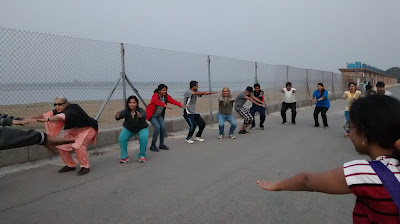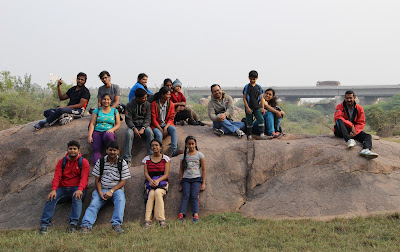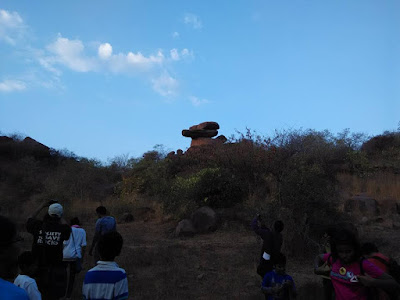Face your Fears. And what could be more fearsome than some adventurous water sports for a person who does not know how to swim.
The planning started the night
before. I had seen a post in meetup from GHAC regarding a kayaking opportunity some time back. I wanted to experience it and the next day being a Saturday, I thought it could be the perfect way to spend my morning. I registered for the same, tossed a pair of shorts and T shirt into my backpack, set the alarm at 5:00AM and went to sleep early. In the morning, when the alarm
rang, I woke up and finished my morning routine. I had planned to start around 7:30
to reach the place by 8:00. But since there was an early morning errand that I
had to do, I started around 7:00. Finished the errand and was on my way to
Hussain Sagar.
Driving in a Saturday winter morning
in the long Christmas weekend at Hyderabad is sheer pleasure. The population in
this city comprises of many IT migrants. Thus, you can be sure that on a long
weekend, half of the city has gone out somewhere. This in fact is a boon to
those who stay back. On such a day, one can finally see how wide the roads in Hyderabad
are. There is no encroachment of roads by any vendors or pedestrians or stationary
vehicles. You can drive in peace in the top gear, without any noise or smoke in
your face. The cool weather is an added
bonus. For someone who is used to drive at 20kmph maximum speed in the city
traffic, a traffic free road is like sheer heaven.
The Hussain Sagar lake, an
artificial lake in the centre of Hyderabad was built in 1562. It is spread
across an area of 5.7 square kilometers and is fed by River Musi. There is a
beautiful boulevard called the necklace road that which connects NTR Gardens to
Sanjeevaiah Park. There are many public green spaces, beautiful lawns, parks,
restaurants and recreation facilities
and good views of the city of Hyderabad that line up along this boulevard.
These are some of the pride of Hyderabad.
My destination was Sanjeevaiah
park, which is one such parks dedicated to Damodaram Sanjivayya, a former Chief
Minister of Andhra Pradesh. I cruised along the necklace road
and reached my destination. After buying a morning walker ticket for Rs 5, I went
inside the park. Built on 92 acres (37 ha) along the banks of Hussain Sagar
lake, Sanjeevaiah park won the Best Open Landscape Award during the 2010 Indian
National Trust for Art and Cultural Heritage award presentations.
At 8:00 in the morning, there was
an unusually sharp chillness in the air. There were few people going in and
coming out of the park. They were morning walkers and those who wanted to do
some exercise in the fresh air. The chirping of the birds could be heard all
over.
There is something serene and
peaceful about Old parks, that I love. I think parks are like wine. The older
they are, the more curated they are, the better they are. New parks somehow do
not have the grace and serenity of the old, well maintained ones. Sanjeevaiah park
is one such park that has a grace and charm of its own.
The first thing that strikes you
when you enter the park is the greenery. There are tall trees which line up the
walk way. Then there is a smooth coating of clean and uncluttered green grass
towards your side and beds of colorful flowers arranged neatly in the distance.
The morning sun was spreading its golden light all over the park and one could
feel the warming effect of the dappled light between trees against the chill
air. The early morning sun light rendered a bright yellow hue on the green
grass and the trees.
My thoughts went back to the
parks that I have seen in Australia and Europe. I felt really good that we have
such a beautiful park here in Hyderabad. And I was also ashamed that after having
spent almost 10 winters in Hyderabad, I had never visited this place earlier.
I walked further down crossing
morning walkers and joggers who were doing their constitutionals. I saw a tall
bearded young man who was doing head stands on the lawn. Some places in the
lawn, I could see white egrets, moving solo or in groups. They seemed to be feasting
on the insects in the grass. On my left, I could see the waters of the lake. In
fact, Sanjeevaiah park is like a small peninsula, a small land mass protruding
into the water body. I had to cross the park completely to come to the end
where my destination for the morning was.
Finally I came to a place where there
was a very broad iron gate. Behind the gate, was a large shipping container
painted green, with some posters and pictures pasted on its wall. It announced –
‘The Yacht Club of Hyderabad’.
I went inside the gate and to the
front of the container and then discovered that the container was in fact a
make shift locker room. A narrow strip of land extended in front of it, all the
way till a small concrete watch tower. There were yachts and boats of various
shapes that were stacked on the strip. I could get a great view of the Hussain
Sagar lake from there. Many water birds were peacefully floating in the water.
There was a strong breeze and the atmosphere was very serene. There were some folks
kayaking and some other milling around. I was anticipating a good experience!
Further down the strip, there
were 2 men who were seated on white plastic chairs. They had a white plastic
table in front of them with some papers on it. I checked in with them. They already
had my details from the payment gateway where I had made the advance payment. I
paid the rest of the amount. They gave me an instruction and disclaimer sheet
to read and sign. They asked me if I was a swimmer or non-swimmer and gave me a
red hand band as a non-swimmer to put on and a food token.
They told the locker room is
behind and asked me to change into shorts and remove my shoes. Back in the
locker room, I stashed my phone, wallet, car keys, bag, changed into shorts and
walked back near the jetty.
There was an instructor who
helped me put on the safety life jacket. You have to wear it as a normal jacket
and zip it in front. There is a thigh and a chest strap which has to be
fastened. It was very tight initially, but then he helped me loosen it and make
it a comfortable fit. I learnt that the jacket can support weight up to 130 Kg.
It seemed to be filled with some light material like foam which increased the
volume. I felt bulked up. This I guess works on the Archimedes principle displacing
more weight of water than its own weight, thus keeping it floating.
Having worn the jacket, we were
instructed on the various parts of the paddle and the kayak. I do not remember
all the names. But the critical thing was that there is a mark in the paddle
which you have to have in your right hand. They told us how to hold it and how
to paddle, how to maneuver, etc.
Then, we were told how to sit in
the kayak. They were long triyaks, meaning it could hold 3 people. Each of them
had a coach and 2 other learners. The coach sat in the back. I was supposed to
sit in the middle. It was a bit of an experience getting into the Kayak. The
kayak was bit unstable in the water and once you put your feet, it felt as if
it would topple. So, one has to be a bit
careful while going in. The instructor help people get in. Since I sat in the
front in my next round, I felt that sitting in the front is a bit more
comfortable than in the back. There is more leg space in front. In the back,
you have to keep the legs raised high on the sides of the front rower. This
makes it an uncomfortable position for the uninitiated.
Once you sit comfortably, they
will hand you the paddles. The coach sitting at the back will shout commands,
left, left, left, right, left, right. This means you have to paddle on that
side. It is very important to synchronize between the three. So basically, the
first rower has to be followed. Again, if you sit in the front, it is easier as
you don’t have to follow anyone but others follow you. While sitting in the middle, I
was time and again told by my coach that I was not following the first. Since
we had to paddle hard, I did not have time to look at the expanse of the lake. I
was focusing on the paddles. Though I had some fear before going into it, I didn’t
actually felt nervous.
Anyways, we went to a blue mark
in the lake about 125 meters from the jetty. There he told us how to turn
around. If you have to turn right, you have to paddle on the left only and vice
versa. Again, we paddled hard and came back towards the jetty. My thighs
started becoming sore by being in the uncomfortable position. My partner was
very enthused and wanted to go for another round. I also agreed and we went for
the second round. By the time we returned back to the jetty, I was tired! More
than that, I was feeling very thirsty. I must have been in water for a maximum
of 20 minutes by then.
So, I alighted and took rest.
Suddenly, I saw another person
coming towards me fully drenched. Upon inquiring, I found that their kayak
capsized and he was rescued.
I took some rest, had water and
again went in to another kayak. This time I choose to sit in front. It was
quite comfortable. In fact, while sitting in middle I thought the person at
front will have to see the entire lake and that would be scary. But it was
actually not so. We kayaked for some distance and then I felt my partner who
was perched in the middle not paddling. I asked him what happened. He said back
pain and he gave up. So, I and the coach, both of us paddled back to the
jetty.
I enjoyed while paddling this
time. I had learnt the trick. I knew that you have to put the whole paddle inside
the water and pull it with all your strength, left side and then right side. It
was great to move in the water like this. The water was splashing and wet my
legs and some on my face. But that was ok.
Back at the jetty, the breakfast
was ready. Hot idli, chutney and sambhar were served to all. After all the hard
work, it was delicious. It was around 9:30 and being hungry since morning, I
could have had much more than the 4 pieces that were served. That followed by a
cup of tea.
I met Suheim Sheikh, the founder
of the Yacht club. He explained all the activities that they do there including
supporting under privileged children learn sailing. There were many sailing and
kayaking course that they offered. He said that this was an expensive sport but
it is a rewarding one. And as per him, Hyderabad yacht club is one of the best
in the country.
Post the breakfast and chitchat,
there was to be a kayak race. I was hesitating to take part. But the in the
last moment, I joined. There were 16 participants and we made teams of 4. Our
team was led by Gautam, a boy of about 11 or 12 who was one of the coach. The
first pair from our team went in. They came back first. Then I and another guy
went in. Again I was in the middle as he went in first. We started strong. Gautam
was prodding us to go faster and faster. Somewhere something happened and in
the next moment, the kayak capsized. I could not understand what went wrong. Suddenly,
I found myself in the cold water. I went face down. But the life jacket helped
me stay afloat. I did not panic. That was the first instruction that was given
to us earlier. Then I tried to roll myself up to face upwards. I saw all the 3
of us in water. The coach asked me to hold the kayak that was toppled over. By
that time, the rescue guys had spotted us and within minutes they arrived near
us. First they lifted up my partner. Then someone asked my specs and I gave it
to him. They asked me to move to the side of the rescue boat. Then they held me
by the jacket and pulled me out of the water on to the boat. It was over in
matter of minutes. I was shivering in
the cold. They asked me if I had drank any water and I replied in negative. The
rescue boat took us safely to the jetty where we alighted. Having fallen down from the kayak and being rescued from the water, I completed the full experience of kayaking!
Then there was a sailing offer
using sail boats. Though I wanted to try that, I was not carrying enough money.
Anyways, it had already been a marvelous experience and I did not want an
overload of adventure for one day. It was great fun and exercise. This will
remain as a good memory with me. I would recommend you all to spend at least one of your weekend morning trying this out. You will feel refreshed, energetic and earn some bragging rights!
And the sailing will be done some
other day, for sure!
 The Element: How Finding Your Passion Changes Everything by Ken Robinson
The Element: How Finding Your Passion Changes Everything by Ken Robinson



















